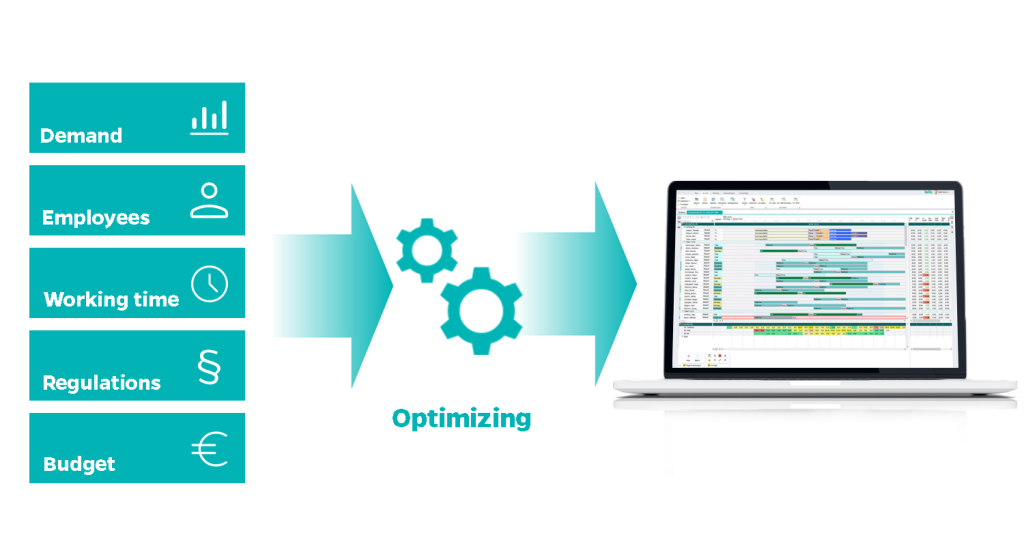Optimized Shift Scheduling: How Modern Workforce Management Revolutionizes Personnel Deployment with 4 Measures

In today’s ever-changing business world, where flexibility plays a key role, efficient and fair scheduling is becoming more and more of a challenge. Companies are faced with the task of making optimum use of resources, complying with legal regulations and at the same time ensuring the satisfaction of their employees. Manual personnel scheduling is not only time-consuming, but also error-prone and often not very flexible. This is exactly where modern workforce management software solutions come into play. By using intelligent algorithms, they help companies to optimize personnel scheduling and gain numerous advantages.
Contents
↓ What is Optimized Personnel Scheduling?
↓ How does Optimized Scheduling Work?
↓ Benefits of Optimized Scheduling for Companies
What is Optimized Personnel Scheduling?
Optimized personnel scheduling means that the entire planning process is not only designed efficiently, but is also adapted to the specific requirements and goals of a company. The aim is to achieve optimum staff deployment while taking into account the needs and wishes of employees and complying with legal and company regulations at all times.
But how exactly is this optimization achieved? The answer lies in the automation and flexibility of modern software solutions, which considerably simplify planning processes and at the same time increase the quality of the entire planning process.
Challenges of Traditional Personnel Scheduling
Traditional shift scheduling faces several challenges that commonly arise in practice:
Time consumption and prone to errors:
Manual scheduling is generally very time-consuming and can easily lead to mistakes that significantly impact business operations.
Inflexibility in short-term changes:
Illnesses, vacations, or unforeseen business events often require last-minute adjustments, which can be difficult to implement without a flexible software solution.
Employee dissatisfaction:
An unequal distribution of shifts and duties can lead to dissatisfaction and conflicts among staff if individual needs are not taken into account.
Also, check out our article on fair scheduling with fairness accounts.
How does Optimized Scheduling Work?
Modern software solutions like plano WFM use advanced algorithms that supports personnel scheduling. By using such technologies, the challenges described above can be handled much more easily in daily planning.
Here is an overview of the key features and benefits of optimized scheduling:
1. Automation of scheduling
The automation of personnel scheduling is a key component of modern WFM tools. Instead of spending many hours manually creating schedules, a planner can generate an optimal plan or plan proposal in minutes with the support of the software. All relevant factors are taken into account, from legal working time regulations to individual employee preferences and availability. Depending on company requirements, these factors can be weighted individually and automatically incorporated into the schedule proposal.
In daily operations, the effort involved in planning is significantly reduced through the automation of scheduling, leaving more time for other important tasks.
2. Compliance with legal and company regulations
Modern scheduling software solutions ensure that legal regulations, collective agreements, and company policies are always automatically adhered to. This not only prevents manual errors but also ensures that planning is legally compliant at all times. For example, working time laws, break regulations, and rules regarding overtime and night shifts can be automatically integrated into the scheduling process. Companies benefit from significant time savings and legal certainty, which are crucial for smooth operations.
Also, check out our article on maximum working time.
3. Considering employee preferences
Employee satisfaction is a critical factor in a company’s productivity. Modern workforce management enables the automatic recording and integration of employees’ individual wishes, such as preferred working hours or vacation requests, into personnel scheduling. This not only promotes employees satisfaction, but also enhances employee retention because employees who feel their needs are valued are more likely to feel appreciated in their role.
4. Scenario planning and flexibility
A key component of optimized scheduling is the ability to create multiple planning variants. In a dynamic work environment, changes often occur at short notice, such as sudden illnesses or unforeseen events. A modern workforce management solution allows planners to simulate multiple scenarios and choose the optimal solution for each situation, always considering factors such as demand, employee preferences, skills, or working hours.
This flexibility ensures that companies can respond to changes at any time without compromising the quality of planning. An additional benefit is that the software, through scenario simulations, prepares for future events, making long-term planning even more efficient.

Benefits of Optimized Scheduling for Companies
Implementing optimized scheduling brings numerous benefits. These range from time savings and better compliance with regulations to higher employee satisfaction:
Time savings and increased efficiency:
The planning effort is drastically reduced, leaving more time for strategic tasks.
Higher employee satisfaction:
Individual preferences and needs of the employees are automatically considered in the scheduling process. This leads to greater satisfaction and also strengthens employee retention.
Ergonomic scheduling:
Automated scheduling takes into account employees’ natural biorhythms, optimizing shift patterns, ensuring adequate rest periods, and promoting health-conscious working hours.
Compliance with legal and company regulations:
Optimized scheduling automatically and error-free incorporates all relevant regulations and rules.
Flexibility in short-term changes:
Changes such as illness or last-minute vacation requests can be quickly and easily integrated into the schedule.
Conclusion:
Optimized Scheduling as the Key to Success
Optimized scheduling is no longer just a “nice-to-have”; it is a key success factor for modern, future-proof companies. By using modern software solutions, companies can significantly improve their personnel scheduling processes while simultaneously increasing employee satisfaction. A flexible, automated system like plano WFM ensures that schedules are not only created quickly but also meet the needs of all parties involved.
Discover how you can make scheduling in your company more efficient, flexible, and more satisfying for everyone involved.
Would you like to find out more?
Further information about our workforce management software and the areas of application here:
→ Workforce Management from plano
Archive
Employee Retention in Retail
We’re Here for You
